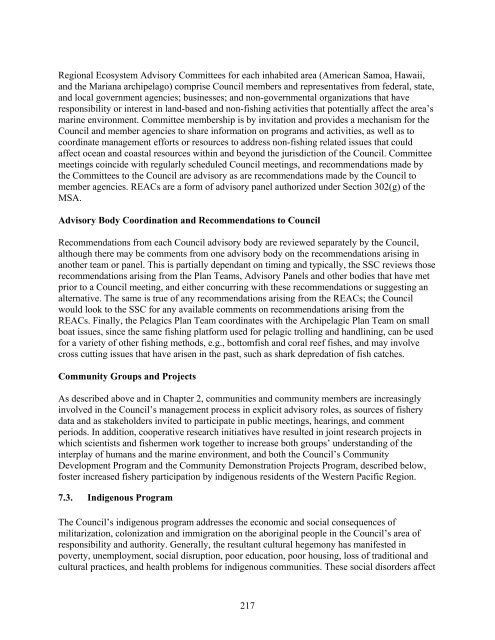Hawaii FEP - Western Pacific Fishery Council
Hawaii FEP - Western Pacific Fishery Council
Hawaii FEP - Western Pacific Fishery Council
Create successful ePaper yourself
Turn your PDF publications into a flip-book with our unique Google optimized e-Paper software.
Regional Ecosystem Advisory Committees for each inhabited area (American Samoa, <strong>Hawaii</strong>,and the Mariana archipelago) comprise <strong>Council</strong> members and representatives from federal, state,and local government agencies; businesses; and non-governmental organizations that haveresponsibility or interest in land-based and non-fishing activities that potentially affect the area’smarine environment. Committee membership is by invitation and provides a mechanism for the<strong>Council</strong> and member agencies to share information on programs and activities, as well as tocoordinate management efforts or resources to address non-fishing related issues that couldaffect ocean and coastal resources within and beyond the jurisdiction of the <strong>Council</strong>. Committeemeetings coincide with regularly scheduled <strong>Council</strong> meetings, and recommendations made bythe Committees to the <strong>Council</strong> are advisory as are recommendations made by the <strong>Council</strong> tomember agencies. REACs are a form of advisory panel authorized under Section 302(g) of theMSA.Advisory Body Coordination and Recommendations to <strong>Council</strong>Recommendations from each <strong>Council</strong> advisory body are reviewed separately by the <strong>Council</strong>,although there may be comments from one advisory body on the recommendations arising inanother team or panel. This is partially dependant on timing and typically, the SSC reviews thoserecommendations arising from the Plan Teams, Advisory Panels and other bodies that have metprior to a <strong>Council</strong> meeting, and either concurring with these recommendations or suggesting analternative. The same is true of any recommendations arising from the REACs; the <strong>Council</strong>would look to the SSC for any available comments on recommendations arising from theREACs. Finally, the Pelagics Plan Team coordinates with the Archipelagic Plan Team on smallboat issues, since the same fishing platform used for pelagic trolling and handlining, can be usedfor a variety of other fishing methods, e.g., bottomfish and coral reef fishes, and may involvecross cutting issues that have arisen in the past, such as shark depredation of fish catches.Community Groups and ProjectsAs described above and in Chapter 2, communities and community members are increasinglyinvolved in the <strong>Council</strong>’s management process in explicit advisory roles, as sources of fisherydata and as stakeholders invited to participate in public meetings, hearings, and commentperiods. In addition, cooperative research initiatives have resulted in joint research projects inwhich scientists and fishermen work together to increase both groups’ understanding of theinterplay of humans and the marine environment, and both the <strong>Council</strong>’s CommunityDevelopment Program and the Community Demonstration Projects Program, described below,foster increased fishery participation by indigenous residents of the <strong>Western</strong> <strong>Pacific</strong> Region.7.3. Indigenous ProgramThe <strong>Council</strong>’s indigenous program addresses the economic and social consequences ofmilitarization, colonization and immigration on the aboriginal people in the <strong>Council</strong>’s area ofresponsibility and authority. Generally, the resultant cultural hegemony has manifested inpoverty, unemployment, social disruption, poor education, poor housing, loss of traditional andcultural practices, and health problems for indigenous communities. These social disorders affect217












